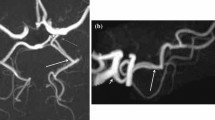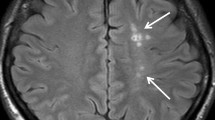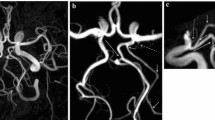Abstract
We present what we believe is the first report of a patient with an anomalous artery arising from the distal basilar artery and fusing with the mid-portion of an extremely long P1 segment of the left posterior cerebral artery that was diagnosed on magnetic resonance (MR) angiography. Careful review of MR angiographic images is important to detect rare arterial variations, and partial maximum-intensity-projection images aid their identification on MR angiography.





Similar content being viewed by others
References
Caruso G, Vincentelli F, Rabehanta P, Giudicelli G, Grisoli F (1991) Anomalies of the P1 segment of the posterior cerebral artery: early bifurcation or duplication, fenestration, common trunk with the superior cerebellar artery. Acta Neurochir (Wien) 109:66–71
Gunnal SA, Farooqui MS, Wabale RN (2015) Studies of posterior cerebral artery in human cadaveric brain. Anat Res Int 2015:681903
Kapoor K, Singh B, Dewan LI (2008) Variations in the configuration of the circle of Willis. Anat Sci Int 83:96–106
Lasjaunias P, Berenstein A, ter Brugge KG (2001) The caudal internal carotid artery division. In: Lasjaunias P, Berenstein A, ter Brugge KG (eds) Surgical neuro-angiography. Vol 1. Clinical vascular anatomy and variations. 2nd edn, Springer, Berlin Heiderberg New York, pp. 521–562
Padget DH (1944) The circle of willis. Its embryology and anatomy. In: Dandy WE (ed) Intracranial arterial aneurysms. Comstock Publishing Co Inc., Cornell University, pp 67–90
Trandafilović M, Vasović L, Vlajković S, Đorđević G, Stojanović B, Mladenović M (2016) Fenestrations and various duplications of the posterior communicating artery in the prenatal and postnatal periods. World Neurosurg 91:172–182
Uchino A, Saito N, Takahashi M, Okano N, Tanisaka M (2016) Variations of the posterior cerebral artery diagnosed by MR angiography at 3 tesla. Neuroradiology 58:141–146
Uchino A, Suzuki C (2016) Temporal branch of the posterior cerebral artery arising from the posterior communicating artery diagnosed by MR angiography. Surg Radiol Anat 38:153–155
Uchino A, Suzuki C, Tanaka M (2015) Extremely long posterior communicating artery diagnosed by MR angiography: report of two cases. Surg Radiol Anat 37:565–568
Zeal AA, Rhoton AL Jr (1978) Microsurgical anatomy of the posterior cerebral artery. J Neurosurg 48:534–559
Acknowledgements
We thank Rosalyn Uhrig, M.A. for her editorial assistance in the preparation of this manuscript.
Author information
Authors and Affiliations
Corresponding author
Ethics declarations
Conflict of interest
We declare no conflict of interest.
Rights and permissions
About this article
Cite this article
Matsuda, M., Uchino, A., Saito, N. et al. Duplicate origin and extremely long P1 segment of the posterior cerebral artery diagnosed by MR angiography. Surg Radiol Anat 39, 699–702 (2017). https://doi.org/10.1007/s00276-016-1769-8
Received:
Accepted:
Published:
Issue Date:
DOI: https://doi.org/10.1007/s00276-016-1769-8




